Rajgira paratha is a healthy gluten-free flatbread made with amaranth flour (known as rajgira atta in Hindi), mashed potatoes and seasonings. Usually these rajgira roti or paratha are made during fasting or vrat days. Rajgira is one of the commonly used ingredients for Hindu religious fasting. Apart from these parathas you can also make Rajgira ki poori and Rajgira kheer for vrat or upwas.

Since there is no gluten in amaranth flour, rolling the amaranth roti dough can be a bit tricky. I have shown two methods in the step by step photos below for rolling the roti. Choose whatever method suits you.
I add mashed potatoes to the dough which helps to roll the roti easily. Another tip is to add bubbling hot water instead of potatoes. Mix very well with a spoon and cover the flour mixture. When slightly hot then knead the dough.
As we like potatoes, I always add them to these parathas. But when making rotis with some other non-glutinous flour, I add hot water and knead.
These amaranth paratha can be made even during regular days. They are very healthy as amaranth or rajgira are healthy seeds. Since they are grown locally in India, they are easily available and not expensive.
These amaranth roti stay soft even after cooling, so they make a nutritious tiffin box snack too.
How to make Rajgira Roti or Paratha
1. First boil 2 small to medium potatoes in a steamer or pressure cooker or pan or Instant pot till they are thoroughly cooked and of a mashable consistency.

2. In a pan or bowl take the amaranth/rajgira flour. I ground the flour at home using raw amaranth grains. ½ cup of amaranth grains yielded about ¾ cup flour.
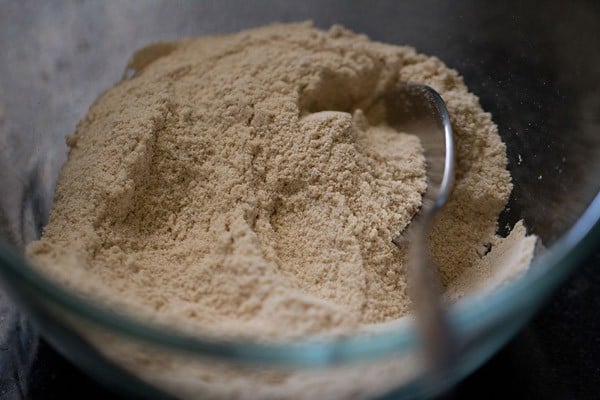
3. When the potatoes are slightly hot or warm, peel them. Then mash them well with a fork or potato mashed and add to the amaranth flour.
Then add the 1 to 1.5 teaspoon crushed green chili paste, ½ teaspoon cumin powder and rock salt (sendha namak). You can also add some chopped coriander and ginger paste.
You can crush 1 green chili in a mortat pestle.
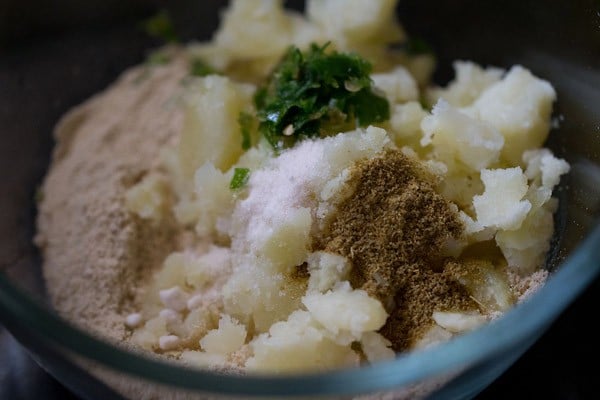
4. Mix everything well.

5. Add 1 or 2 tablespoons of water in parts and knead to a smooth dough. The addition of water depends on the quality of the flour. Hence add as accordingly.
Make sure you don’t add too much water. Allow the dough to come at room temperature as it will be slightly warm due to the addition of the hot or warm mashed potatoes.
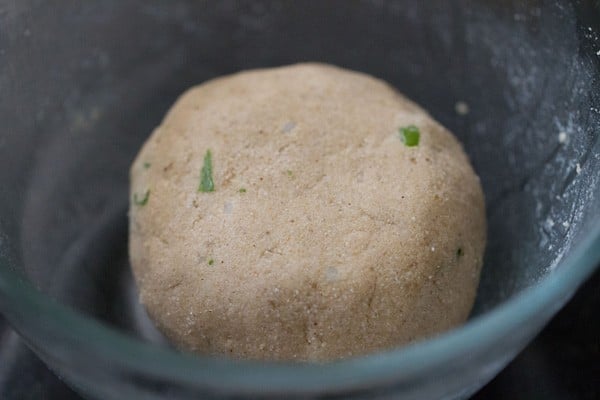
Method 1 – rolling rajgira roti
1. Make a small or medium sized balls from the dough on a rolling board. Dust lightly with amaranth flour.
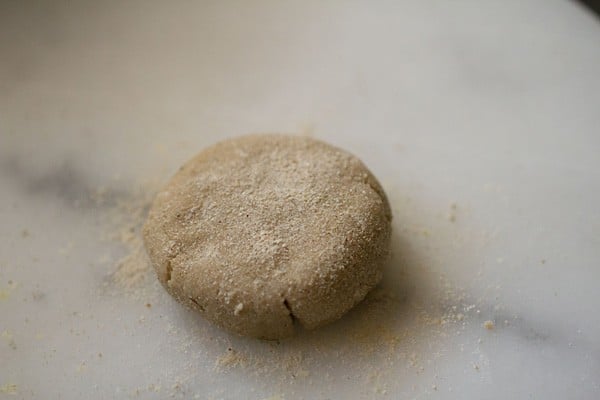
2. With a rolling pin, gently roll to a small or medium sized roti. While rolling add some more flour if required. Roti rolled this way have uneven edges. You can also roll keeping the dough ball on top of a zip lock bag.
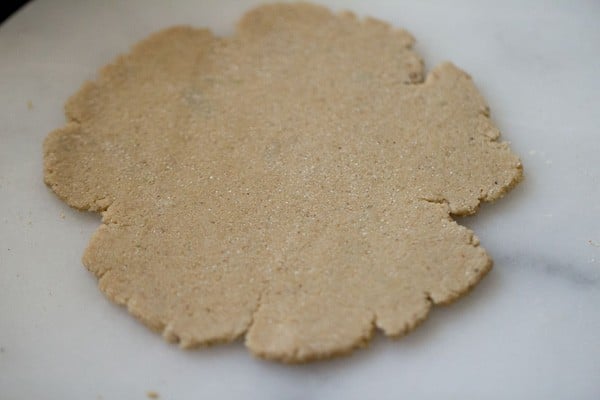
3. Then gently and carefully lift up with a spatula.
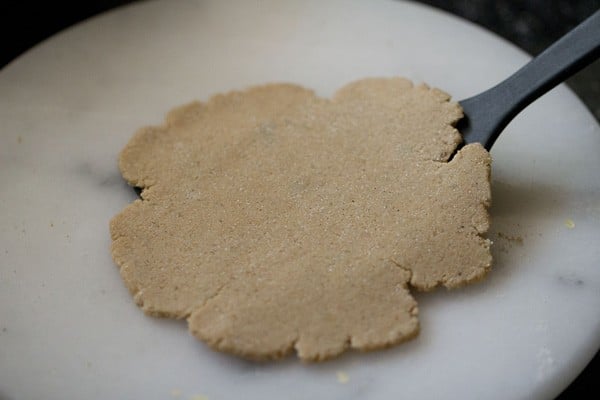
4. And place them on a hot tava or skillet or frying pan.
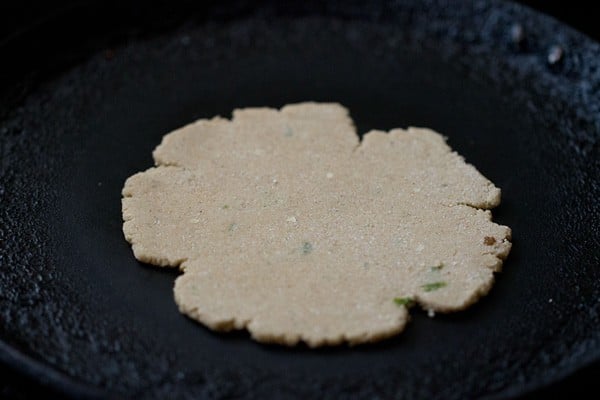
Method 2 – patting the dough to make amaranth roti
1. Keep a moist kitchen cotton napkin or kitchen towel in your workplace. Take a small or medium sized ball from the dough and place it on the moist kitchen cloth.
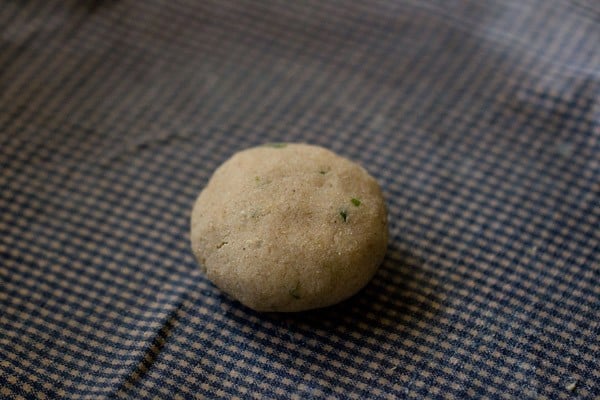
2. With your palms or with your fingers, gently pat the dough ball and flatten it to a neat round circle of dough as shown in the next step.

3. The edges come out neat this way and are not uneven unlike the first method.
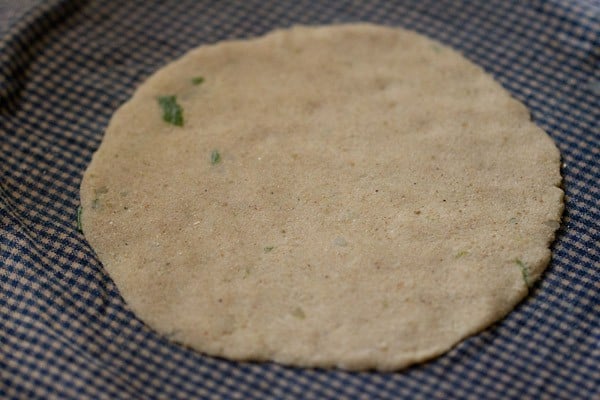
Cooking rajgira paratha
4. Now gently remove the paratha from the cloth or place the cloth upside down on a hot tava or skillet and peel of cotton cloth. I do the first method of removing the paratha from the cloth and then placing it on the hot tava.
Keep the heat to medium to medium-high. Regulate the heat as needed.
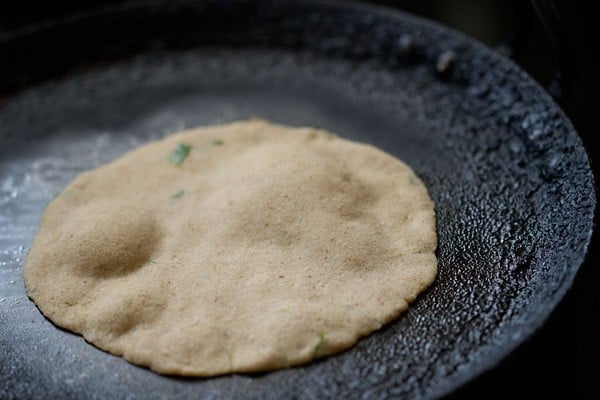
5. When one side of paratha is partly cooked, flip with the help of spatula. Use a non-stick pan or well seasoned pan as the paratha might stick.
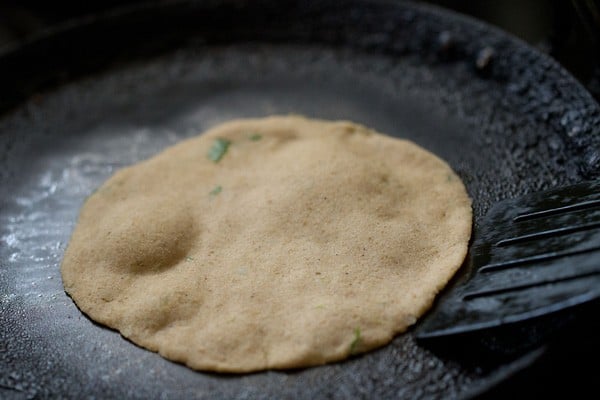
6. Apply ghee or oil on this side.

7. Flip again with a spatula.
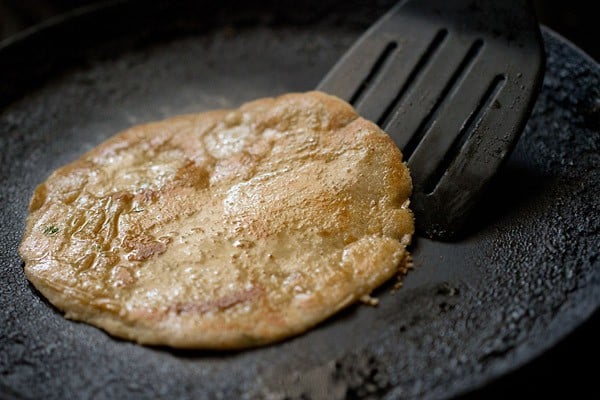
8. This is the second side which has got browned at some spots.
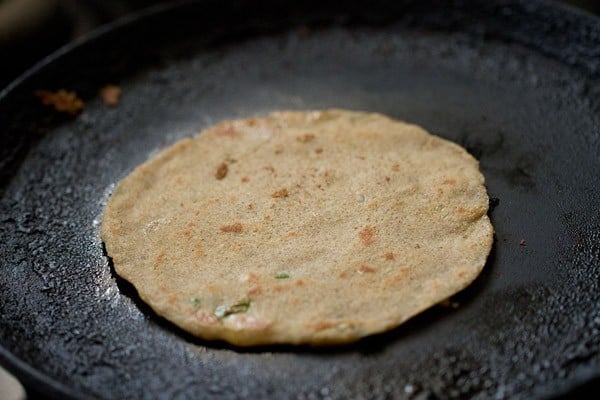
9. Apply ghee or oil on this side as per your preferences.
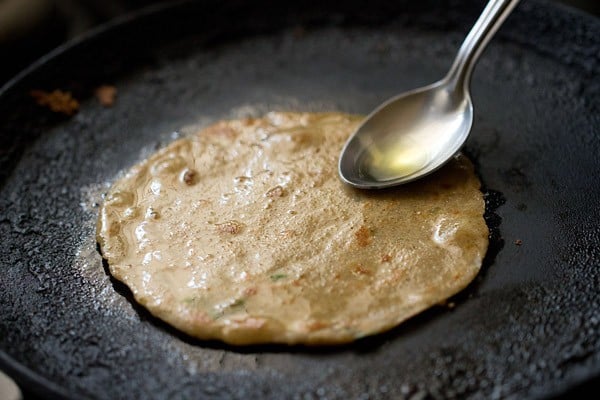
10. Flip a couple of times till the rajgira paratha has become evenly golden and roasted evenly.
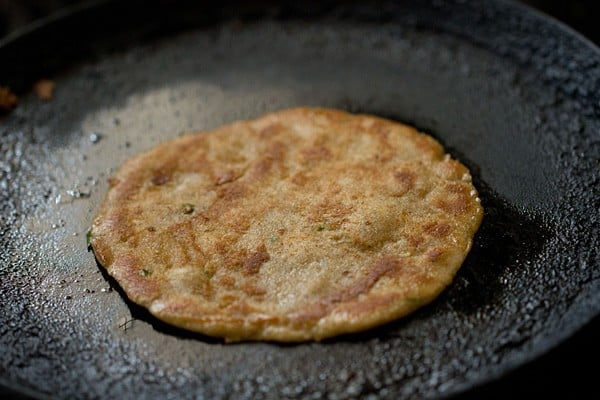
11. Serve these rajgira roti or paratha hot or warm with curd or any curry meant for fasting like:

Few more Navratri recipes on blog are:
If you’ve tried this recipe, please rate it in the recipe card or leave a comment below – I’d love to hear your feedback. For more vegetarian inspiration, sign up for my email updates or follow me on Instagram, Youtube, Facebook, Pinterest or X.

Rajgira Roti | Amaranth Paratha
Ingredients
- ¾ cup amaranth flour (rajgira atta)
- 2 small to medium potatoes or 1 large potato or ½ to ⅔ cup tightly packed mashed potatoes or 100 to 125 grams potatoes
- ½ teaspoon Cumin Powder (jeera powder)
- 1 or 2 green chilies – crushed or finely chopped or 1 to 1.5 teaspoon crushed green chilies
- rock salt (edible and food grade) (sendha namak) as required. used specially for religious fasting days or vrat.
- ghee or oil as required
Instructions
Making dough
- First boil 2 small to medium potatoes in a steamer or pressure cooker till they are thoroughly cooked and of a mashable consistency.
- In a pan or bowl take the amaranth flour. I ground the flour at home using raw amaranth grains. ½ cup of amaranth grains yielded about ¾ cup flour.
- When the potatoes are slightly hot, peel them. Then mash them lightly and add to the amaranth flour.
- Then add the crushed green chili paste, cumin powder and rock salt (sendha namak). You can also add some chopped coriander and ginger paste. Mix everything well.
- Add 1 or 2 tablespoons of water in parts and knead to a smooth dough. The addition of water depends on the quality of flour. Hence add as accordingly. Make sure you don't add too much of water. Allow the dough to come at room temperature as it will be slightly warm due to the addition of the hot mashed potatoes.
Method of rolling rajgira roti
- Make a small or medium sized balls from the dough. Dust with amaranth flour.
- Roll to a small or medium sized paratha. While rolling add some more flour if required.
- Then gently lift up with a spatula and fry the paratha on a hot tava.
Method of patting the dough to make rajgira roti
- Keep a moist kitchen cotton napkin or towel on your workplace. Take a small or medium sized ball from the dough and place it on the moist kitchen cloth.
- With your palms or with your fingers, gently press the dough ball and flatten it till till it increases in size. The edges come out neat this way and are not uneven.
Making rajgira roti
- Now gently remove the paratha from the cloth or place the cloth upside down on a hot tava or skillet and peel of cotton cloth. I do the first method of removing the rajgira paratha from the cloth and then placing it on the hot tava.
- One side is partly cooked, flip with the help of spatula. Use a non-stick pan or well seasoned pan as the paratha might stick.
- Apply ghee or oil on this side as per your preferences. Flip again carefully using a spatula. Apply ghee or oil on this side.
- Flip a couple of times till the roti has become evenly golden and roasted evenly.
- Serve these rajgira roti hot or warm with curd or any curry meant for fasting like vrat ki kadhi or vrat ke dahi aloo or kaddu sabji or vrat ki aloo sabji.
Notes
- The recipe can be scaled as per your requirements.
- Make sure that the amaranth flour is fresh and in its shelf period if using packaged one.
- Don’t add too much water when kneading as the dough will become sticky and pasty.
- You can choose to skip any of the spices in the recipe according to your preferences.
- Roast them on medium to medium-high heat. Regulate the heat as needed.
- For a vegan version roast them with peanut oil. If making during non-fasting days then you can use any neutral flavored oil also.
- The approx nutrition info is for one amaranth paratha roasted with ½ teaspoon of peanut oil.
Nutrition Info (Approximate Values)
This Rajgira Roti post from the archives (March 2015) has been republished and updated on 11 October 2021.

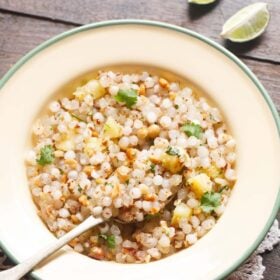











Love this recipe.
Hi Dassana, love all your recipes, your website is my go to place for recipes while cooking. I tried making these rotis using store bought flour, but they have a bitter after taste. Is it normal? Or do you think the flour is rancid?
Thanks Archana. The flour has gone rancid and thus the bitter taste. It happens. Sometimes the flours are not fresh enough when packaged and become rancid soon. Rajgira or amaranth has a nice mild sweet and nutty taste.
I tried this recipe with a slight variation, I further added sama ka atta (half the quantity of rajgira atta) while kneading the dough. Adding the mashed boiled potatoes definitely helps to
bind.
thanks ketaki for the review and the suggestions. adding any flour meant for fasting is perfectly doable. yes mashed potatoes do help in binding.
Are these rotis bitter?
no they are not. rajgira does not have a bitter taste. it has a slightly nutty flavor.
Request u for more recipes using rajgira …
Annapurna, I will try to add.
Nice recipe.
Can you please add any Rajgira recipe which is dry and can be carried in tiffin and remains in good condition till evening time?
i have taken a note of your request and will try to add.
Thanks
Welcome Lalita
Farali flour available ftom the shops is a blend of all the different farali flours,rajigaro,singoda and samo…..do you know what proportions the different flours make up the blend?
no sujata i do not know. usually i use only one flour or two different farali flours in half-half proportion.
Where do u get the flour in USA ?
try in a local indian grocery store. if you don’t get, then buy amaranth grains and grind them as required in a mixie to a fine powder. you should be able to get amaranth grains easily there.
wow so nice. sure i will try this week end n let u know
thanks chithra
Where to buy Rajgira in Delhi??
ambica, in a good super store. you might get it locally also in kirana shop.